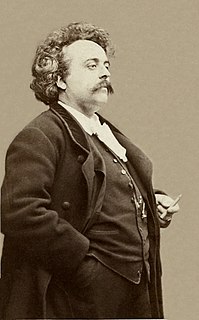
François Auguste René Rodin, known as Auguste Rodin, was a French sculptor. Although Rodin is generally considered the progenitor of modern sculpture, he did not set out to rebel against the past. He was schooled traditionally, took a craftsman-like approach to his work, and desired academic recognition, although he was never accepted into Paris's foremost school of art.
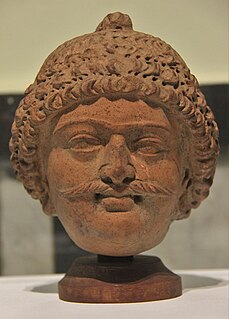
Terracotta, terra cotta or terra-cotta, a type of earthenware, is a clay-based unglazed or glazed ceramic, where the fired body is porous. Terracotta is the term normally used for sculpture made in earthenware, and also for various utilitarian uses including vessels, water and waste water pipes, roofing tiles, bricks, and surface embellishment in building construction. The term is also used to refer to the natural brownish orange color of most terracotta, which varies considerably.

The Legion of Honor is a part of the Fine Arts Museums of San Francisco (FAMSF). The name is used both for the museum collection and for the building in which it is housed. Since Nov 1, 2018, Thomas P. Campbell serves as its Director and CEO.
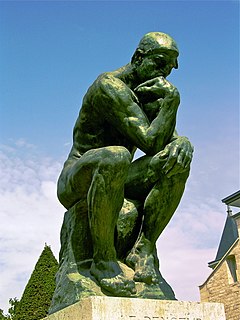
The Thinker is a bronze sculpture by Auguste Rodin, usually placed on a stone pedestal. The work shows a nude male figure of over life-size sitting on a rock with his chin resting on one hand as though deep in thought, often used as an image to represent philosophy. There are about 28 full-sized castings, in which the figure is about 186 cm high, though not all were made during Rodin's lifetime and under his supervision. There are various other versions, as well, several in plaster, and studies and posthumous castings exist in a range of sizes. Rodin first conceived the figure as part of his work The Gates of Hell commissioned in 1880, but the first of the familiar monumental bronze castings did not appear until 1904.
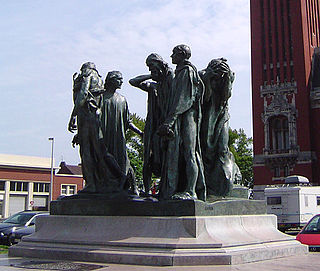
Les Bourgeois de Calais is one of the most famous sculptures by Auguste Rodin. It commemorates an event stated to have occurred during the Hundred Years' War, when Calais, a French port on the English Channel, was under siege by the English for about eleven months. Calais commissioned Rodin to create the sculpture in 1884 and the work was completed in 1889.

The Musée Rodin in Paris, France, is a museum that was opened in 1919, dedicated to the works of the French sculptor Auguste Rodin. It has two sites: the Hôtel Biron and surrounding grounds in central Paris and just outside Paris at Rodin's old home, the Villa des Brillants at Meudon (Hauts-de-Seine). The collection includes 6,600 sculptures, 8,000 drawings, 8,000 old photographs, and 7,000 objets d’art. The museum receives 700,000 visitors annually.

The Kiss is an 1882 marble sculpture by the French sculptor Auguste Rodin. The embracing nude couple depicted in the sculpture appeared originally as part of a group of reliefs decorating Rodin's monumental bronze portal The Gates of Hell, commissioned for a planned museum of art in Paris. The couple were later removed from the Gates and replaced with another pair of lovers located on the smaller right-hand column.

The Gates of Hell is a monumental sculptural group work by French artist Auguste Rodin that depicts a scene from the Inferno, the first section of Dante Alighieri's Divine Comedy. It stands at 6 metres high, 4 metres wide and 1 metre deep (19.7×13.1×3.3 ft) and contains 180 figures. The figures range from 15 centimetres (6 in) high up to more than one metre (3 ft). Several of the figures were also cast independently by Rodin.

The International Exposition of 1867, was the second world's fair to be held in Paris, from 1 April to 3 November 1867. Forty-two nations were represented at the fair. Following a decree of Emperor Napoleon III, the exposition was prepared as early as 1864, in the midst of the renovation of Paris, marking the culmination of the Second French Empire. Visitors included Tsar Alexander II of Russia, a brother of the emperor of Japan, Kaiser Wilhelm and Otto von Bismarck of Prussia, Prince Metternich and Franz Josef of Austria, Ottoman Sultan Abdülaziz, and the Khedive of Egypt Isma'il.

The Age of Bronze is a bronze statue by the French sculptor Auguste Rodin (1840–1917). The figure is of a life-size nude male, 72 in. high. Rodin continued to produce casts of the statue for several decades after it was modelled in 1876.

Monument to Balzac is a sculpture by Auguste Rodin in memory of the French novelist Honoré Balzac. According to Rodin, the sculpture aims to portray the writer's persona rather than a physical likeness. The work was commissioned in 1891 by the Société des Gens de Lettres, a full-size plaster model was displayed in 1898 at a Salon in Champ de Mars. After coming under criticism the model was rejected by the société and Rodin moved it to his home in Meudon. On July 2, 1939 the model was cast in bronze for the first time and placed on the Boulevard du Montparnasse at the intersection with Boulevard Raspail.
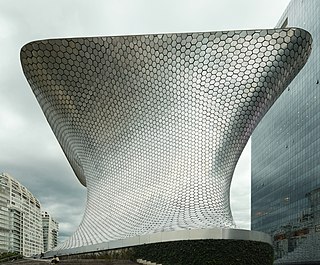
The Museo Soumaya is a private museum in Mexico City and a non-profit cultural institution with two museum buildings in Mexico City - Plaza Carso and Plaza Loreto. It has over 66,000 works from 30 centuries of art including sculptures from Pre-Hispanic Mesoamerica, 19th- and 20th-century Mexican art and an extensive repertoire of works by European old masters and masters of modern western art such as Auguste Rodin, Salvador Dalí, Bartolomé Esteban Murillo and Tintoretto. It is considered one of the most complete collections of its kind. The museum is named after Soumaya Domit, who died in 1999, and was the wife of the founder of the museum Carlos Slim. The museum received an attendance of 1,095,000 in 2013, making it the most visited art museum in Mexico and the 56th in the world that year. In October 2015, the museum welcomed its five millionth visitor.

Eternal Springtime is a c. 1884 sculpture by the French artist Auguste Rodin, depicting a pair of lovers. It was created at the same time as The Gates of Hell and originally intended to be part of it.

Man with the Broken Nose is a sculpture by Auguste Rodin created between 1863 and 1864 and approved by the Salon in 1875. It is considered the first by Rodin in which life is represented over the grace pervading the academic circles and aesthetic of the time.

An Athlete Wrestling with a Python was the first of three bronze sculptures produced by the British artist Frederic Leighton. Completed in 1877, the sculpture was a departure for Leighton, and heralded the advent of a new movement, New Sculpture, taking realistic approach to classical models. It has been described as a "sculptural masterpiece" and as "possibly Leighton's greatest contribution to British art". Despite its indebtedness to the Classical tradition, it can be understood as one of the first stirrings of modern sculpture in Britain as well as in Europe. The Athlete was arguably the most influential piece of English sculpture of the 19th century.
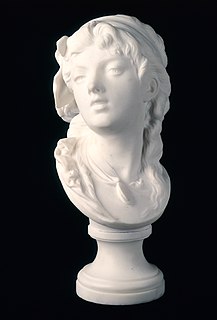
Suzon is an early bust of a woman by Auguste Rodin, created between 1872 and 1873 when he wholly worked on commissions. It was inspired by late 18th century Romantic works whilst Rodin was in exile in Brussels due to the Franco-Prussian War. He created it in homage to Albert-Ernest Carrier-Belleuse, another sculptor also in exile there who was highly influential on Rodin's early works.

French sculpture has been an original and influential component of world art since the Middle Ages. The first known French sculptures date to the Upper Paleolithic age. French sculpture originally copied ancient Roman models, then found its own original form in the decoration of Gothic architecture. French sculptors produced important works of Baroque sculpture for the decoration of the Palace of Versailles. In the 19th century, the sculptors Auguste Rodin and Edgar Degas created a more personal and non-realistic style, which led the way to modernism in the 2Oth century, and the sculpture of Pablo Picasso, Georges Braque, Marcel Duchamp and Jean Arp.


